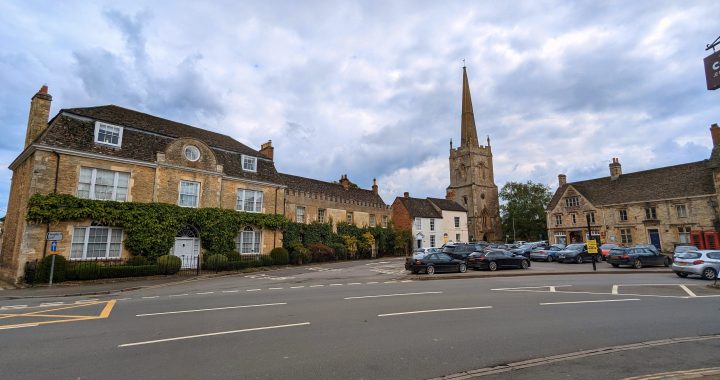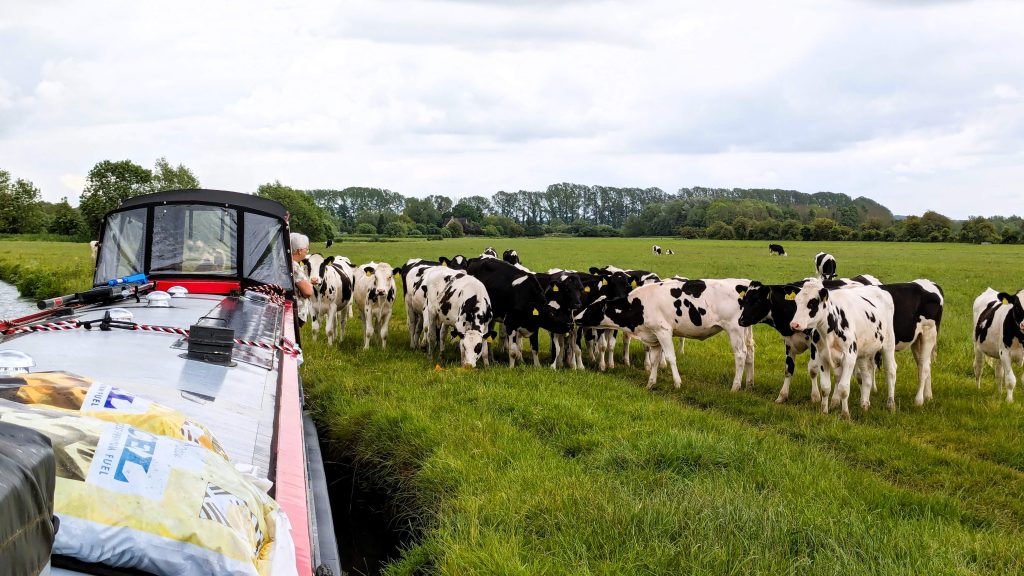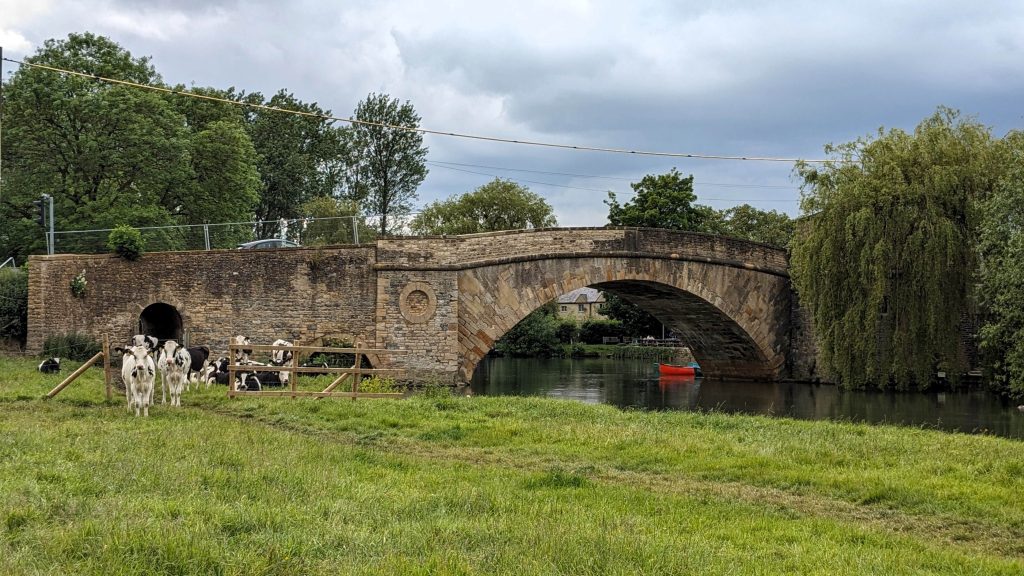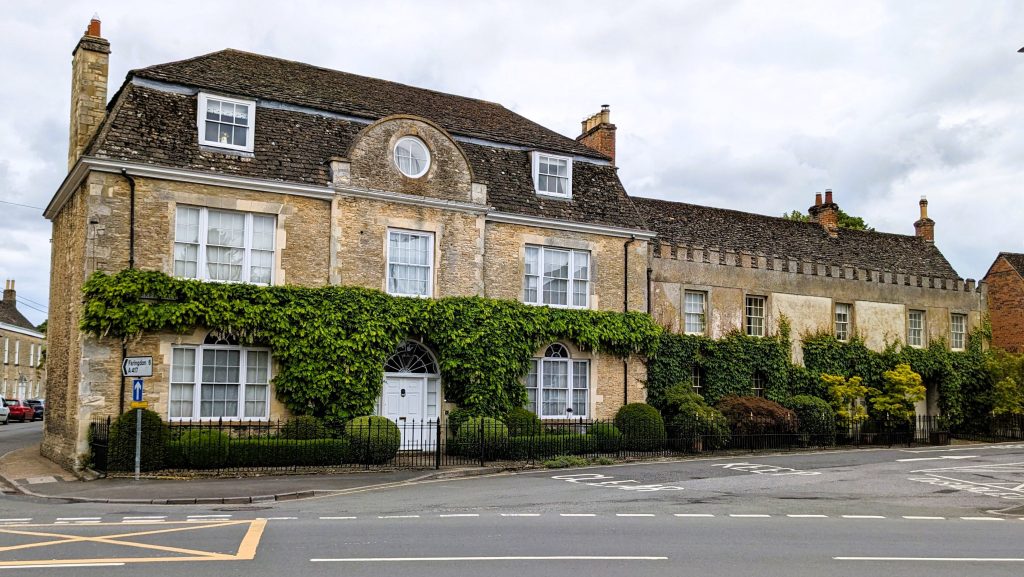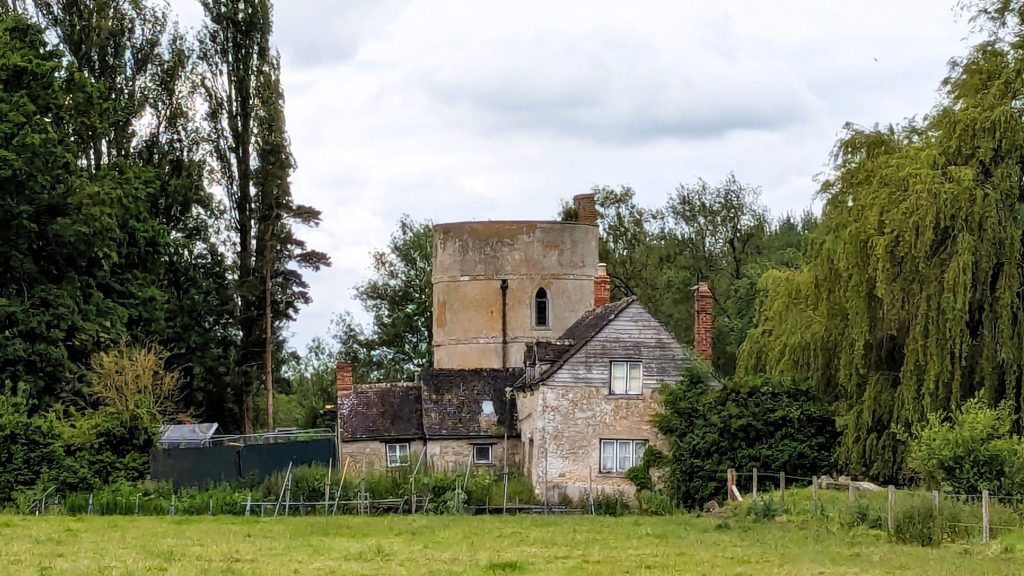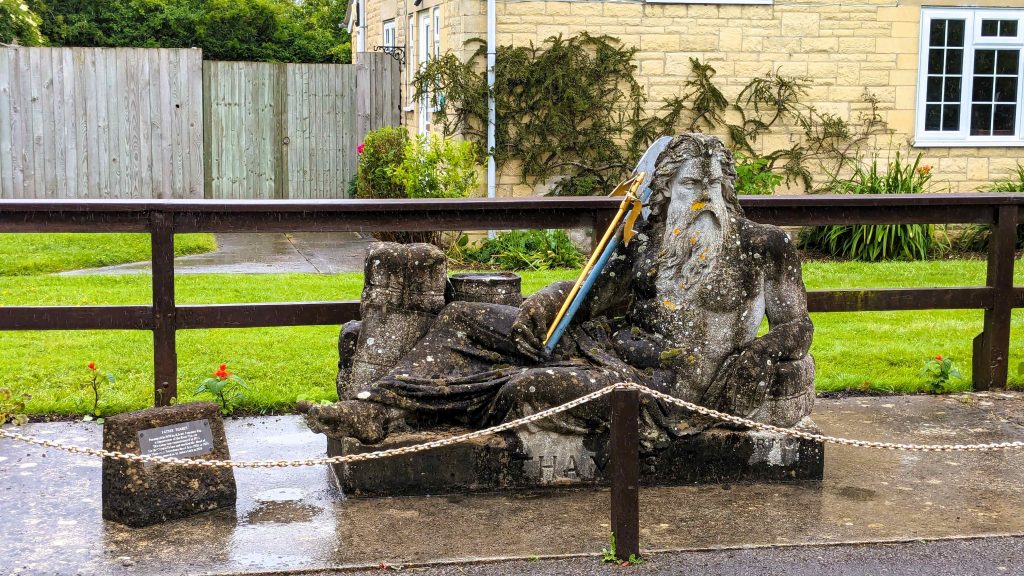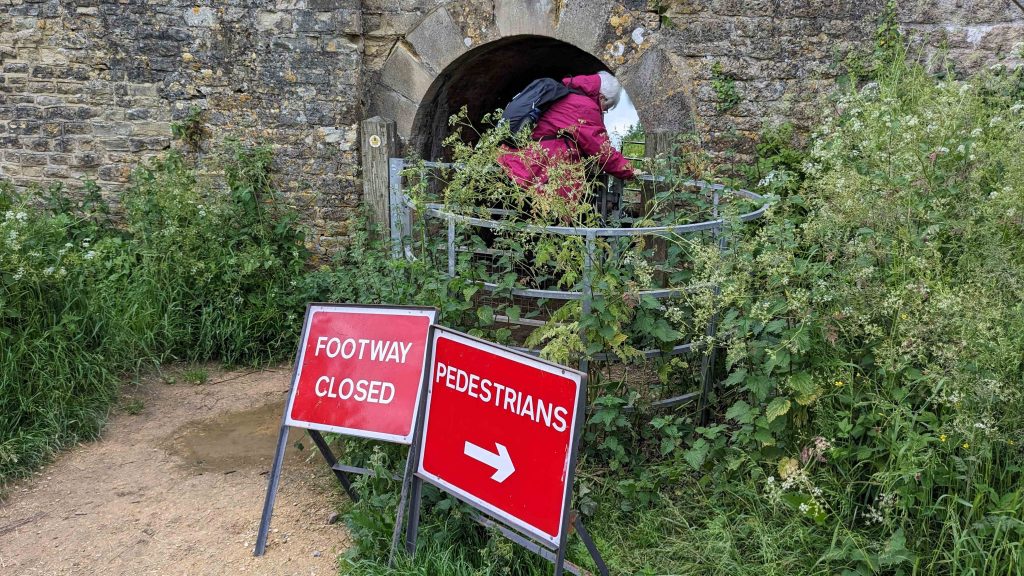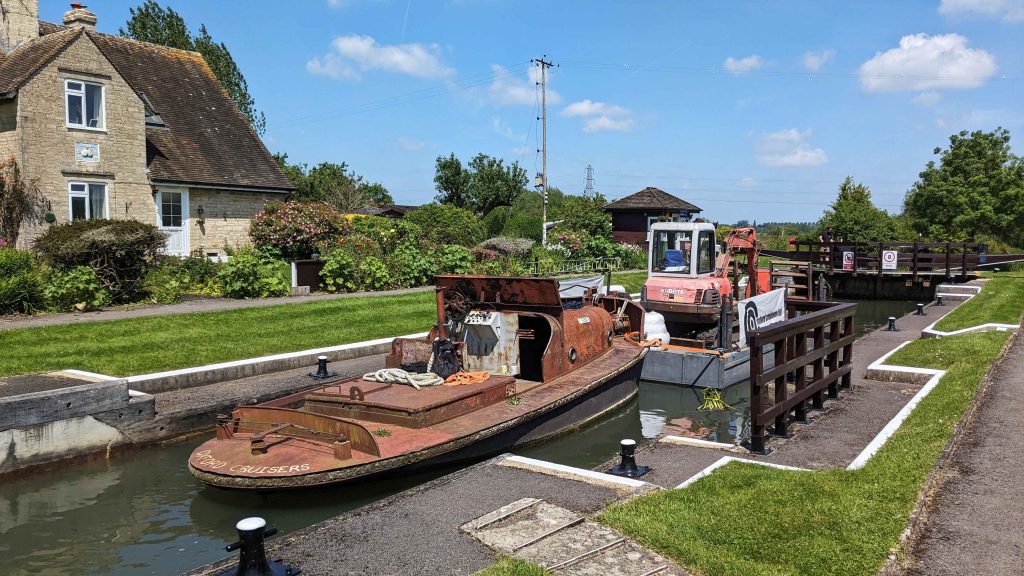Search For The Source
We are not doing this, of course.
The exact location of the source of the Thames depends on who you talk to and it can also vary in response to the weather. However, there is a consensus that it is in Gloucestershire, fairly near Cirencester.
The last point at which you could reasonably turn a narrowboat is at Ha'penny Bridge in Lechlade-on-Thames and is effectively, the navigable limit of the Thames for us, so around twenty-five miles short of the source.
However, Lechlade had been getting a good press all along our journey so we were happy to be heading there before starting a return trip back downstream.
Lowlights In Lechlade
Since Banbury, we had enjoyed some pretty good weather, overall, with one or two days standing out as notable exceptions. Tuesday, the twenty-ninth of May, was another poor day and not one where we could just stay inside and ignore it, as our forty-eight hour mooring would be up today.
With nothing in the forecast to suggest a particularly good time to travel, we set off on our final leg up to Lechlade while it was still dry. That only lasted ten minutes or so and the rain became steadily heavier and more persistent for the rest of the morning. The increasingly sinuous nature of the river reached a peak during this section, with continual twists and turns through multiple hairpin bends, one after the other, this way and that. There is a fine compromise between keeping the speed down to cope with the turns and keeping the revs up to manage the current. Finally, we arrived at the meadow below Ha'penny Bridge, a key landmark for Lechlade, where you can moor along the river bank, although it is likely that the landowner may come and ask for a mooring fee.
We were surprised to find that we were the only visitors moored along here but got the boat secured and prepared ourselves to visit the town. We had heard good things about Lechlade, as a pretty riverside village and a great place to stay for a few days. Maybe it was the poor weather, perhaps it was the fact that the only route to the town had been closed off by the council or maybe we just weren't in the mood but whatever the reason, we came away massively underwhelmed.
The bridge had been damaged and the path beneath it had been closed off 'for reasons of public safety' until such time as waters receded enough for the council to effect a repair. As a result, we had to go some way out of our way to reach a gate that we then had to climb over to walk along a very fast, busy road, with no footway, to reach the bridge across to the town. When we did reach it, the things that most struck us were the number of shops and businesses that were closed down, how filthy the windows and frontages along the main street were and the heavy traffic running through the town.
It soon became clear that, with our usual impeccable timing, we had arrived on early closing day, so many of the shops that were still in business were shut this afternoon. We hadn't seen a supermarket since Eynsham so we did need a few things quite urgently, although our main shopping order was being delivered by Sainsbury's on Wednesday morning. Budgen's were open in the centre, the butcher who had been highly recommended by a number of people was also open and we managed to find the Co-op store, which turned out to be just an adjunct to the Texaco petrol station, way out on the outskirts, on the A361.
As we returned to the boat, by the same tortuous route, we had to wonder how well the shopping delivery was going to work, as the nearest point we had been able to choose for delivery was the pub car park at the foot of the bridge on the far side of the river. At this point we realised that the herd of cows, which had been far off in the distance when we first arrived, were now clustered around our mooring.
We shooed them off and clambered aboard feeling somewhat deflated. Archie, however, could just not move on. Whenever the herd came round again he would freak out and when he was taken outside he could not concentrate on anything but "where are the cows?".
Lechlade Redeemed?
A new dawn brought a new perspective. After a bit of rain overnight, there was a bright, golden haze on the meadow. We watched a few people walking towards the bridge most of whom just climbed through the barrier. We had seen that, as they completed each circuit of their grazing area, the cows liked to get into the bridge arch as well, so you needed to play the cowboy sometimes to drive them out before you could get through but it certainly beat the alternative route.
So, while I emptied our spare fuel into the tank, Sue headed over to the car park to meet the Sainsbury's driver. I followed up with the trolley, which we loaded up, pulled across the bridge and ran down onto the path. We then unloaded it, manhandled the trolley over and reloaded it on the other side before hauling it back to the boat. It all went unexpectedly well and with the day's critical mission accomplished, we were able to head back up into Lechlade before lunch.
With the surviving businesses open, the sun shining and some assistance from the ladies at the tourist information desk in the library the place took on a much nicer feel, especially in the outskirts and back streets, although the A361 continued to dominate the centre.
I did rather like the old-fashioned looking garage that almost looked as if it was incorporated into the Baptist Church.
We had some lunch at the Lynwood Café, which proved excellent, then spent the afternoon following a couple of walks around the town. The Seven Stiles Trail took us over to the riverside park on the opposite bank and along the Thames Path to the Inglesham Round House, before circling across and back up to the west of the town.
The Round House is being restored by the Cotswold Canal Trust and is one of thirty that were built for the lockkeepers that worked on the Thames & Severn Canal. The canal itself, linked the Thames at Inglesham with the Stroudwater, near Stroud, which gave access to the River Severn. It succumbed to competition from the railways at the end of the nineteenth century and was mostly abandoned in the nineteen-twenties.
We then followed Shelley's walk from Market Square by the church to Wharf Lane. The walk is named for Percy Bysshe Shelley, who visited the church and was inspired by it to write 'A Summer Evening Churchyard', one of his more famous poems. Our route continued beyond the town and along to The Trout Inn by St. John's Lock, where we crossed to take the Thames Path again and return to the boat for tea. At the lock we passed the statue of Father Thames.
Commissioned for the Crystal Palace in eighteen fifty-four, it was rescued after the fire in nineteen thirty-six and eventually installed at a traditional head of the Thames, at a place called Trewsbury Mead in nineteen fifty-eight. In nineteen seventy-four, vandalism eventually forced its removal to St. John's Lock, where the lockkeeper can keep an eye on it.
We had an appointment in the early evening, an AGM of our little development's management company, to be held via something called 'Teams', which I had only recently succeeded in eradicating from my new laptop. We decided to brave the cattle and the gate climb once more (well twice actually) to visit the New Inn and ensure a good wi-fi connection for the session (that was our story).
The meeting was as materially dull and as unintentionally amusing as one should expect but the pub seemed a nice place, although we had to keep ourselves on mute to avoid giving the game away.
Back Down The Bends
Thursday, the thirtieth of May, saw us leave Lechlade on a grey, breezy morning and head back downstream.
While moored at Lechlade we had eyed, enviously, the mooring outside the New Inn garden which had been occupied by "Barley Twist". Being on the other side of the river it would have been a far more convenient place to moor for getting the shopping and avoiding the cows. As we left and headed down to moor up for the first day back at Kelmscott, that berth was empty. Sure enough, right there in the spot that, on Sunday, we had made our own, was "Barley Twist" again.
We ended up having a couple of goes at finding another spot and managed to get in eventually. We had quite a long chat with "Barley Twist", without rancour. They were based on the Wey Navigation but had been up and down the Thames for years as well. They were able to give us some good advice about mooring around Oxford, which was probably going to be our next big challenge. It was also clear we were going to be playing leapfrog for a while and probably be in potential competition for the same sites.
On the way up, we had encountered a large wide beam awkwardly moored right on a sharp bend. The same boat was still there but now, narrowing the gap further still, it was attended by a couple of boatyard engineers and a small tug trying to take it in tow. Apparently, it was suffering from engine trouble and needed to go to a boatyard to be repaired. As we were mooring up and chatting with "Barley Twist" we saw the two boats coming downstream, the wide beam with the tug secured to the side of it and trying to guide it. They were coming at pace and trying to go wide to take the bend. At the same time we could see, which they couldn't, the small narrowboat, moored on a little wharf just around the corner, that had chosen that moment to cast off and set off upstream. A certain amount of waving and shouting alerted both parties to each others' presence and they managed to react and pass without incident but it was certainly a close call for both of them.
The next day was grey, cold and very windy all day. We set off back towards a spot we had noted just above Rushey Lock which looked a more comfortable place to moor than back at the Trout Inn at Tadpole Lane.
Before we reached our planned stop we had hoped to get water above Grafton Lock. As we signalled to the lockkeeper that we were pulling in, he signalled back that we should not do so. We moved on to the lock landing itself, past the same wide beam from yesterday. The keeper told us that we couldn't use the water point because the wide beam was in the way and it was there because he had refused to let the tug bring it through the lock. In his view their side-on approach was dangerous and gave them insufficient control. Apparently, the tug crew told him that when they had agreed to collect the boat they had not realised just how big it was.
We had another opportunity to fill the water tanks at Radcot Lock so it wasn't a big problem for us. On the way we came round the sharp bend leading into Radcot Bridge but it didn't present quite as much of a challenge as we had feared it might, at least, not as long as nothing was coming the other way. We moored up as we had planned, close to "Barley Twist", who we had heard leaving Kelmscott at seven forty-five that morning.
The next stop was Newbridge again and we set out on Saturday, the first of June, aiming for a stretch of privately owned river bank upstream from the bridge and the Maybush Inn. Flaming June it wasn't, being dull, grey and cold with a very strong, biting wind. We were primed and ready for Tenfoot Bridge this time and didn't have any problems on the way down. When we did arrive, however, we found that the bankside moorings were not quite as ideal as they had seemed from the water. You had to pick your spot to get into the side and it was a clamber up onto the bank. It turned out that the metal posts we had spotted and assumed were for boats to secure to were nothing of the sort. They were some sort of plastic tubing and we realised they probably marked fishing spots of some kind. We got ourselves sorted in the end and settled down for the afternoon. It was actually a surprise when a guy came to check the sheep in the adjoining field and seeing us moored, came and asked for five pounds. Apparently he rented the grazing from the landowner and part of the deal is that he checks and collects the mooring fees. This was the first time we had actually had to pay for mooring on the Thames, even at Lechlade.
We decided that this constant travelling deserved a night out. We looked at the Maybush Inn, which seemed quite nice but their prices, even in this inflationary meltdown, crossed the line into simple banditry. Conversely, Sue had a Chef & Brewer deal, through Tesco club card, that gave us thirty pounds off, so it was to their Rose Revived that we gave our custom that evening. We came away very satisfied with a very good meal, including a dessert and drinks for us both at sixteen pounds a head. Sue's sister, who always has her eye out for a coupon, would have been very proud.
We moved again on Sunday, this time back to Eynsham, where we expected to stay for at least two nights. As we untied the last line, ready to cast off, around the bend came Oxford Cruisers' barge, complete with JCB on board.
This was the equipment that we had encountered across the channel, on the way upstream, last weekend. It seems their work here was now done and they were heading back to base. We waited for then to pass but then, of course, had a rather slow cruise from then on. They didn't move particularly fast, couldn't really share the locks and were awkward to manoeuvre in and out of them. It would be more trouble than it was worth to try to overtake somewhere, even on the Thames. The bends were still a feature and whenever we do end up passing another boat from behind it is always a painfully slow-motion exercise, unless the other craft comes virtually to a stop and pulls right over. Luckily, it was a lovely, sunny day, so we didn't mind taking a bit longer.
We watched them through Pinkhill Lock and by the time we were through ourselves, accompanied by another boat that had caught up with us and we were passing the Oxford Cruisers boatyard, they were all moored up and sitting in the sun having a drink. It was much busier along the meadow bank at Swinford than it had been previously but we found a space, not too much further from town than before. It was a bit more of a scramble to get tied up and to get on and off the boat but the scene was as peaceful and idyllic as before.
Swinford Bridge was yet another where the Thames Path under the bridge had been closed off, with a diversion up into the traffic to get around it. Last week it had been possible to ignore the signs, they were many months old and seemed out of date. On this visit the barricades and fences were firmly back in place, which added some minor inconvenience and irritation.
We stayed here for two nights, exploring some new parts and visiting those we knew, including lunch at the Cherry Tree Café. It was as nice as before, although despite or perhaps because of, it being a weekday, it was rather cluttered with small children and young parents. It was a little hard to tell which of these made the most noise or were the most disruptive. Either way, this was our last stop before heading down to the city of Oxford and a new set of challenges.

